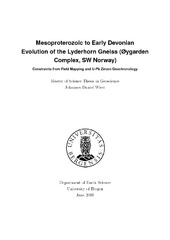| dc.description.abstract | The Øygarden Complex and the Bergen Arc System are intriguing large-scale structures in the SW Norwegian Caledonides, but their formation is still incompletely understood. So far, the lack of published U-Pb zircon ages has limited clear interpretations of the geologic evolution of the Øygarden Complex. The Lyderhorn Gneiss is located in the poorly studied eastern part of the Øygarden Complex and forms the core of the Bergen Arc. Detailed field mapping was conducted and seven samples were dated by SIMS U-Pb zircon geochronology, to study the magmatic and structural formation of the Lyderhorn Gneiss. Igneous protoliths formed during the Mesoproterozoic Gothian-Telemarkian (1504 Ma) and Sveconorwegian (1041 Ma and 1026 - 1022 Ma) orogenic periods. They do not record Sveconorwegian high-grade regional metamorphism. Early Ordovician (483 Ma) thermal resetting of metamict zircons was followed by sustained residence at elevated temperatures that annealed previous radiation damage. The U-Pb zircon system was not affected by Caledonian amphibolite facies metamorphism. The structure of the Lyderhorn Gneiss formed in one single deformation event, recorded in ENE-directed exhumational deformation from amphibolite facies to the brittle-plastic transition. Fluid-assisted strain weakening formed phyllonitic E-dipping detachment shear zones that became finally overprinted by (semi-)brittle deformation. Based on the Mesoproterozoic protolith ages, the Lyderhorn Gneiss and thereby the Øygarden Complex are correlated with the Telemarkia domain of the Baltican basement. The age of magmatism relates the Øygarden Complex with the Sirdal Magmatic Belt of southern Norway. The correlation suggests a continuous NNW-trend of Sveconorwegian domain boundaries and supports the assertion that Sveconorwegian high-T metamorphism in the Baltican basement was rather local than regional. A rapid temperature increase in the Early Ordovician is interpreted to mark the onset of Caledonian convergence. The structure of the Lyderhorn Gneiss is constrained to have formed by Early Devonian extensional deformation. Bidirectional Devonian extension in the Øygarden Complex is explained by exhumation as a Devonian extensional gneiss dome. The proposed, symmetrical core complex style of exhumation, resembles previously identified core complexes in central Norway and allows for a more consistent interpretation of basement culminations along the Norwegian margin. Possible onshore-offshore correlations are suggested for the Utsira High in the northern North Sea. Detailed structural and thermochronological studies will be needed to test the proposed model. | en_US |
